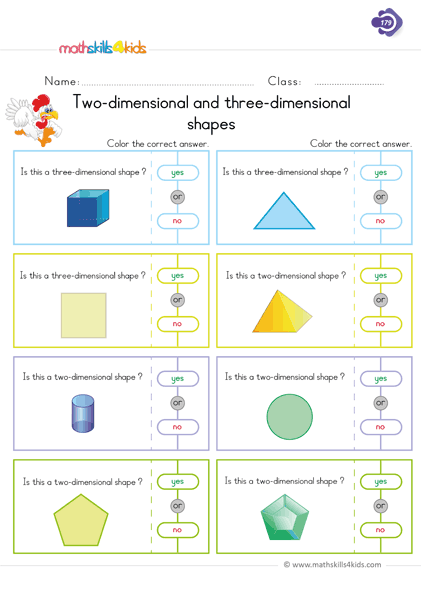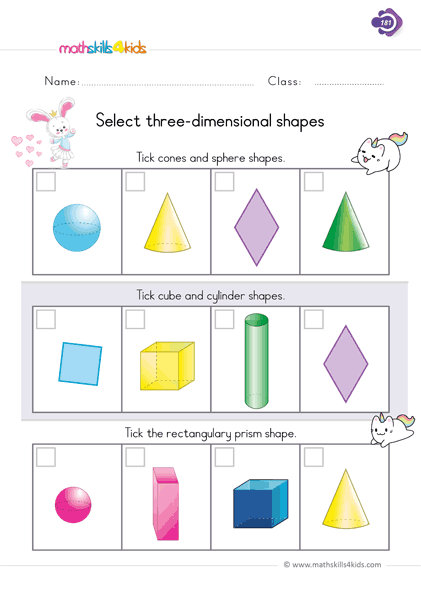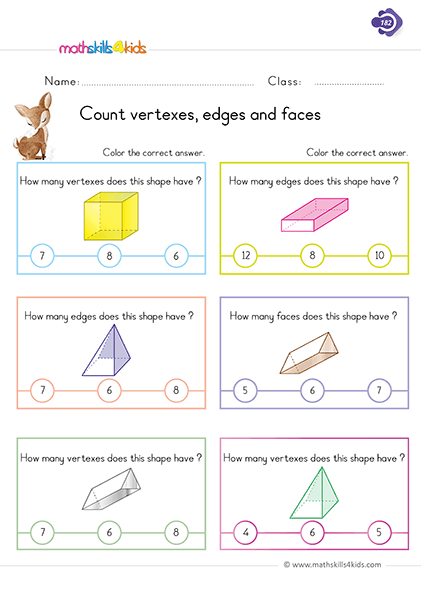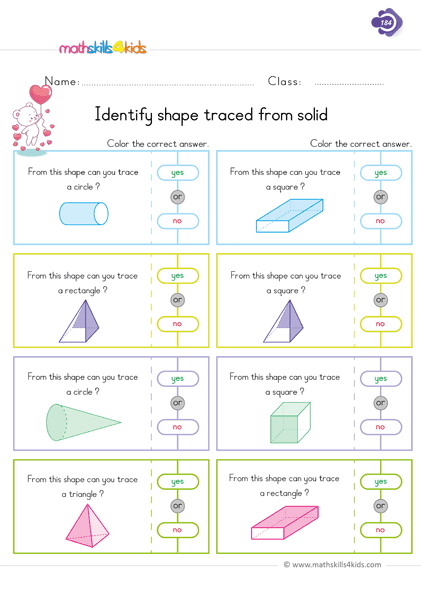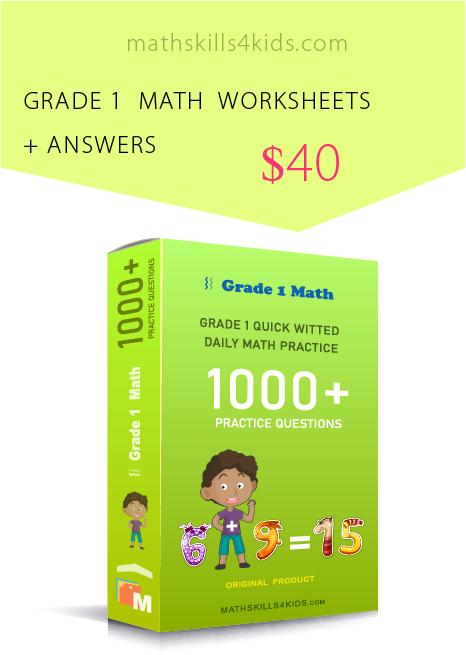Fun and Engaging 3D Shapes Worksheets for Grade 1 Students
Are you looking for some fun and engaging ways to teach 3D shapes to your first graders? If so, you've come to the right place! In this resource, we'll share some of our favorite 3D shapes worksheets and activities for your Grade 1 students to learn about cubes, spheres, cones, cylinders, and more.
-
Learning about 3D shapes is an important part of early math education. Hence, these worksheets are designed to help Grade 1 students understand the characteristics of 3D shapes, including identifying and drawing them.
With engaging activities and colorful illustrations, these worksheets will make learning about 3D shapes fun and easy for your students.
Most importantly, these worksheets are perfect for practice and review, and they also include some creative projects that will spark your students' imagination and curiosity.
Let's get started!
Why 3D shapes matter for Grade 1 students
3D shapes are awesome! They are everywhere in our world, and we can use them to create amazing things. Learning about 3D shapes in Grade 1 helps students develop their spatial awareness and problem-solving skills. They can also have fun exploring different shapes and how they fit together.
3D shapes are not just flat, they have depth and volume. They can be measured, compared, and classified by their properties.
Some examples of 3D shapes are cubes, spheres, cones, cylinders, and pyramids. Can you name some more? Can you find some 3D shapes in your classroom or at home?
Let's discover the wonderful world of 3D shapes together!
-
BROWSE THE WEBSITE
-
DOWNLOAD FREE WORKSHEETS
-
-
1st GRADE MATH TOPICS
- Counting and numbers
- Understand addition
- Addition skills
- Addition exercises
- Addition strategies
- Understand subtraction
- Subtraction skills
- Subtraction Exercises
- Subtraction strategies
- Mixed operation
- Comparing numbers up to 100
- Estimation Worksheets
- Place value
- Spatial sense
- Graphing & data
- Measurement
- Patterns
- Probability
- Sorting & classifying
- Telling time
- 2D shapes
- 3D shapes - Solids figures
- Fractions
-
-
How to introduce 3D shapes to your first Graders
Before you dive into the worksheets, you need to introduce 3D shapes to your first graders in a way that they can understand and relate to. It is also important to understand what 3D shapes are.
3D shapes are objects that have three dimensions: length, width, and height. Unlike 2D shapes, which only have length and width, 3D shapes also have depth.
Some common 3D shapes include cubes, spheres, cylinders, and pyramids. By mastering these shapes, Grade 1 students will have a strong foundation for future math concepts.
Here are some tips to help you understand better:
- Review 2D shapes like squares, circles, triangles, and rectangles. Explain that 2D shapes are flat and have only two dimensions: length and width. You can use a piece of paper or a whiteboard to show them examples of 2D shapes.
- Next, introduce 3D shapes as shapes that have three dimensions: length, width, and height. Explain that 3D shapes are not flat but have thickness and can be held in your hand.
You can use real objects or models of 3D shapes to show them examples of cubes, spheres, cones, and cylinders.
- Compare and contrast 2D and 3D shapes using a Venn diagram or a T-chart. For example, you can ask your students to name some similarities and differences between a square and a cube or a circle and a sphere.
You can also ask them to identify the faces, edges, and vertices of 3D shapes.
- Identifying 3D Shapes. After mastering the difference between 2D and 3D shapes, the next step will be to identify 3D shapes only. These worksheets will give your Grade 1 students plenty of practice in identifying 3D shapes such as cubes, spheres, cylinders, and pyramids.
They'll learn to recognize the unique characteristics of each shape and be able to differentiate between them easily. This interactive worksheet can help your students recognize and identify 3D shapes. With these skills, they'll be well on mastering more complex math concepts.
- Drawing 3D Shapes. Once your Grade 1 students have mastered identifying 3D shapes, it's time to move on to drawing them. These worksheets will provide step-by-step instructions for drawing each 3D shape, allowing your students to practice fine motor skills while reinforcing their understanding of 3D shapes.
They'll be able to create their own cubes, spheres, cylinders, and pyramids in no time! You can use interactive worksheets that can be completed online. They provide instant feedback to improve your students' learning.
- Sorting 3D Shapes. Before your Grade 1 students can start drawing 3D shapes, they need to be able to identify and sort them. These worksheets will provide plenty of opportunities for your students to practice sorting 3D shapes based on their attributes, such as the number of faces, edges, and vertices.
This will help them develop a deeper understanding of the properties of each shape and prepare them for the drawing exercises to come.
- Real-world examples of 3D shapes. To help your Grade 1 students understand the practical applications of 3D shapes, incorporate real-world examples into your lessons. For example, you can show them a cube-shaped box or a sphere-shaped ball.
You can also ask them to identify 3D shapes in their environment, such as a cylinder-shaped can or a pyramid-shaped building. This will help them see the relevance of 3D shapes in their daily lives and make the learning experience more engaging.
-
Fun activities to explore 3d shapes in the classroom
One of the best ways to introduce 3D shapes to your students is to provide them with fun activities to explore 3d shapes in the classroom with their hands.
Here are some fun activities that you can do with your students to help them get familiar with 3D shapes and their properties:
- Shape Hunt: Give each student a clipboard, a pencil, and a shape hunt worksheet. Have them walk around the classroom or the school and look for real-life objects that match the 3D shapes on their worksheet.
They can draw or write the name of the object under each shape. This activity helps students recognize 3D shapes in their environment and connect them to their names.
- Shape Sort: Give each student a set of 3D shape cards and a sorting mat. Have them sort the cards into categories based on their attributes, such as faces, edges, vertices, curved or flat surfaces, etc.
This activity helps students compare and contrast 3D shapes and learn their vocabulary.
- Shape Bingo: Give each student a bingo card with different 3D shapes. Have one student draw a shape card from a pile and name the shape.
The other students check if they have that shape on their bingo card and mark it with a counter or a crayon. The first student to get five in a row (horizontally, vertically, or diagonally) wins.
This activity helps students practice identifying and naming 3D shapes.
- Shape Hunt: Give each student a clipboard, a pencil, and a shape hunt worksheet. Have them walk around the classroom or the school and look for real-life objects that match the 3D shapes on their worksheet.
-
Printable 3D shapes worksheets for practice and review
After your students have explored 3D shapes with hands-on activities, you can use printable 3D worksheets to help them practice and review what they have learned.
Here are some examples of 3D shapes worksheets that you can use in your classroom:
- Shape Match: This worksheet has two columns of pictures: one with 3D shapes and one with real-life objects. Students must draw a line to match each shape with an object with the same shape.
- Shape Properties: This worksheet has a table with four columns: shape name, number of faces, number of edges, and number of vertices. Students have to fill in the missing information for each shape.
- Shape Nets: This worksheet has pictures of different nets that can be folded into 3D shapes. Students have to name the shape that each net makes and color it.
-
Creative projects with 3d shapes for kids
If you want to take your 3D shapes lessons to the next level, you can assign creative projects that involve making or using 3D shapes to your students. Here are some ideas for creative projects with 3D shapes for kids:
- Shape Models: Have your students use clay, playdough, toothpicks, straws, marshmallows, or other materials to make models of different 3D shapes.
You can also have them label their models with the shape name and its properties.
- Shape Art: Have your students use paper, scissors, glue, tape, or other materials to make collages or sculptures using different 3D shapes.
You can also have them write a sentence or a paragraph describing their artwork and the shapes they used.
- Shape Books: Have your students make their own books about 3D shapes using paper, crayons, stickers, or other materials.
They can write facts, stories, poems, riddles, or jokes about 3D shapes. They can also illustrate their books with drawings or photos of 3D shapes.
Tips and resources for teaching 3d shapes effectively
Teaching 3D shapes can be challenging but also rewarding. Here are some tips and resources that can help you teach 3D shapes effectively:
- Use concrete examples: Use real-life objects or models to show your students what 3D shapes look like and how they differ from 2D shapes.
This will help them understand the concept of dimensionality and relate it to their own experiences.
- Use different perspectives: When showing your students pictures or drawings of 3D shapes, use different perspectives and angles.
This will help them see that 3D shapes can look different depending on how you view them and that they must pay attention to their properties to identify them correctly.
- Use games and songs: To make your 3D shapes lessons fun and engaging, you can use games and songs involving 3D shapes. For example;
You can play "I Spy" with 3D shapes or sing "The Shape Song" with 3D shapes.
- Use online resources: If you need more ideas or materials for teaching 3D shapes, you can use online resources such as websites, blogs, videos, or apps that offer 3D shapes worksheets, activities, games, quizzes, or tutorials.
For example, you can check out these websites:
- Math is Fun: This website has a section on 3D shapes that explains their names, properties, nets, and formulas.
It also has interactive animations and games to explore and manipulate 3D shapes.
- Math Salamanders: This website has a section on 3D shapes that offers free printable worksheets, posters, flashcards, and puzzles.
It also has links to other websites that have more 3D shapes resources.
- Education.com: This website has a section on 3D shapes that provides exercises on topics such as identifying 3D shapes, finding surface area and volume, and drawing nets.
Browse Printable 1st Grade 3D Shape Worksheets | Education.com
- Math is Fun: This website has a section on 3D shapes that explains their names, properties, nets, and formulas.
-
Thank you for sharing the links of MathSkills4Kids.com with your loved ones. Your choice is greatly appreciated.
We hope you found these 3D Shapes worksheets from Mathskills4kids helpful and inspiring.
Teaching 3D shapes can be much fun and learning for you and your students. With these worksheets and activities, you can help your students master 3D shapes quickly!
Happy teaching!
